Monster Hunter
“Being a monster hunter was not something I was born into. My father told me to go out and get a trade. He wanted me to apprentice under the finest professional in my field. He didn’t want me to live a poor life growing crop to have it stolen by brigands or richer men. But I don’t think this is what he had in mind…”
– Jürgen of the Black Arrow
A half-orc trudges into town alone. A trail is stained into the soil behind him from the day’s gritty work. He makes his way with an exhausted calm, a hooked scythe in one hand and a beast’s severed head in the other. Gathering villagers look to the head still dripping with gore, then to the half-orc, his gaze emotionless and his expectations clear. Townsfolk scamper to scrape together their promised reward to the monster killer, as they understand this is someone who handles bad faith poorly.
When city folk are laid to rest within the mausoleum, they most often stay there. On this day, however, the dead lazily roam the halls searching for a way out. A skeleton sheathed in tattered skin shatters with a thunderous boom upon shambling over an explosive trap. The sound attracts more rasping zombies, the halfling who set the trap taking careful aim with her crossbow as they wander into her line of fire.
A master and apprentice recite an old chant passed down from their guild as a crowd of royal servants look on warily. The servants’ lord had long feared rumors of a monster living within the castle walls. In their desperation, the lord chose to rely on the chanting pair. Their trust was not in vain, as when the arcanists’ scatter a fistful of shining dust into the royal chamber, one of the maids’ shrieks, twists, and contorts into her true form.
Monster Hunters, as their title suggests, spend their lives hunting and killing all manner of abhorrent creatures. But the stories and legends about these travelers tend to be exaggerated, often suggesting that they are noble knights-errant in search of townships to rescue from local fiends. Other tales tell of sinister loners that cause more problems than they solve, cavorting with the creatures they claim to kill and leaving behind hellish offspring. The truth is far more mundane than common folk are willing to take interest in, as most monster hunters are simply professionals looking for work.
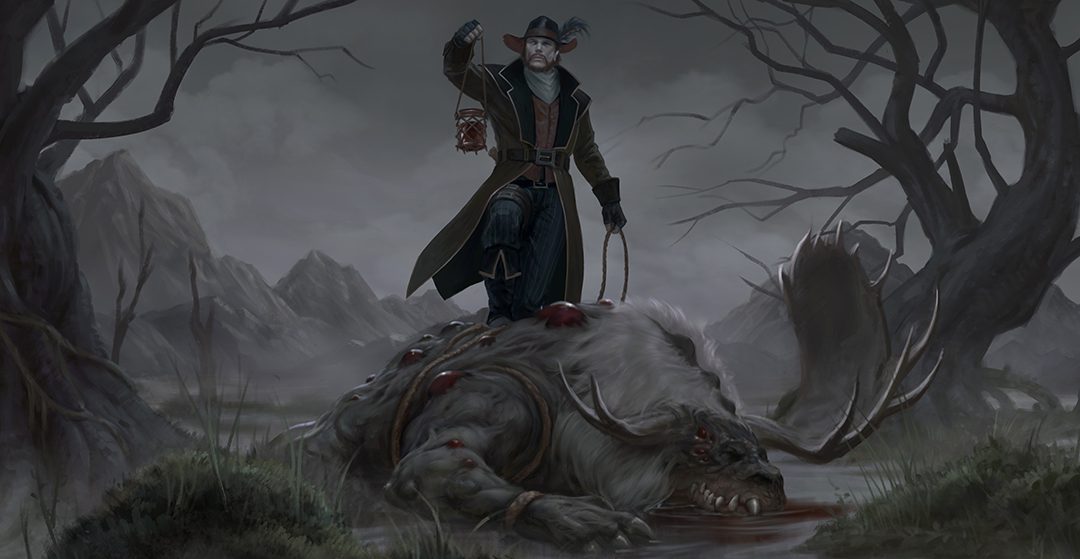
Artist: Andreia Ugrai
Consummate Professionals
Each monster hunter specializes in identifying, seeking, and killing different types of creatures. Therefore, each monster hunter also specializes in different methods for doing so. While some hunters don heavy armor and carry shields to protect against crushing jaws and scything claws, others prefer to remain light and agile to keep distance between themselves and their quarry.
Each guild of hunters operates under their own professional code, and each hunter their own moral compass. Most guilds refuse coin for killing common folk. A hunter will likely object to being sent after other sentient creatures such a warband of Valikan half-orcs or a clan of bugbears yet to be affected by Tormach’s Rage.
Highly Trained Specialists
Monster hunters are typically trained from a young age. They may have apprenticed once old enough to read, write and bear arms, or were themselves raised by members of their own guild.
What separates a monster hunter from other mercenaries is the importance their training places upon education and knowledge. A monster hunter knows that bravado and a strong sword arm are often not enough to survive their preternatural prey. Therefore, they spend years studying alongside their physical training. Such is their learning that a monster hunter could identify a wraith from a specter or differentiate the tracks of a griffin from a manticore.
Creating a Monster Hunter
As you create your monster hunter, there are two main questions to consider.
The first is the nature of your monster hunter training and education. Were you disciplined in a guildhall where the techniques of your trade are the closely guarded secret of your tutors? Or were you mentored on the road by a hunter who took you in?
As a starting character, you’ll choose two monster types that you specialize in hunting. When you reach higher levels, you will also choose a hunting guild which represents the maturing of your knowledge and therefore could reflect the nature of your early education.
Think about why you specialize in hunting certain monster types. Are they the same types of monsters your mentor or guild specialized in? Or did your research branch into other creature types due to special interest? Did your mentor raise you as part of the carver guild, specialized in close quarters fighting against dangerous monstrosities? Or did they tutor you in creating traps and equipment from dragon bones? It also is possible your early training provided you with a broad education or that you are self-taught, only choosing to specialize in later life.
The second question to consider is your motivation for being a monster hunter. Is it purely a professional endeavor for which you expect to be well compensated? Or are you trying to make the world safer one monster at a time?
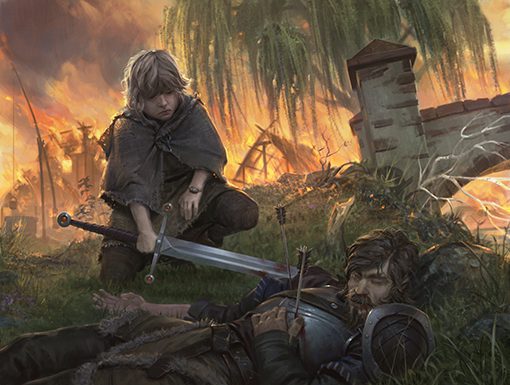
Artist: Marius Bota
Your motivations may be complex and even a source of internal conflict. Perhaps it pains you to slay such rare and misunderstood creatures, but you’ve learned no other way to provide for yourself? Or your guild code forces you to take payment for each beast killed, despite feeling like you’re taking advantage of poor villagers far too often? Perhaps you simply enjoy the challenge of the hunt and the adrenaline you get when a beast lunges?
Your motivations may tie back into the monsters you specialize in. For example, you may be seeking revenge against the types of creatures that destroyed your home or took your mentor away. There may even be beasts you refuse to hunt, or beasts you refuse to take payment for. This could include a conscientious objection to slaying sentient creatures defending their territories from human expansion. Or maybe you so detest the creatures you specialize in hunting that you will gladly seek them out and destroy them with or without compensation.
Quick Build
You can make a monster hunter quickly by following these suggestions. First, make Strength or Dexterity your highest ability score, depending on whether you want to focus on melee weapons or on archery (or finesse weapons). Your next-highest score should be Intelligence.
Second, choose a background that reflects your training and the monsters you specialize in hunting, or alternatively your background could reflect your character’s life before they fell into the monster hunting profession.
If you are using advanced backgrounds from Grim Hollow: The Campaign Guide, the Beast Hunter profession from the Outlander background is perfect for any lifelong monster hunter characters.
Class Features
As a monster hunter, you gain the following class features.
Hit Points
Hit Dice: 1d10 per monster hunter level
Hit Points at 1st Level: 10 + your Constitution modifier
Hit Points at Higher Levels: 1d10 (or 6) + your constitution modifier per monster hunter level after 1st.
Proficiencies
Armor: Light armor, medium armor, shields
Weapons: Simple weapons, martial weapons
Tools: None
Saving Throws: Strength, Dexterity
Skills: Choose two skills from Athletics, History, Investigation, Medicine, Nature, Perception, Religion, and Survival
Equipment
You start with the following equipment, in addition to the equipment granted by your background:
- (a) scale mail or (b) leather armour
- (a) a martial weapon and a shield or (b) two martial weapons
- (a) a light crossbow and 20 bolts or (b) two simple weapons
- (a) a dungeoneer’s pack or (b) an explorer’s pack
Fighting Style
You adopt a particular style of fighting as your specialty. Choose one of the following options. You can’t take a Fighting Style option more than once, even if you later get to choose again.
Archery
You gain +2 bonus to attack rolls you make with ranged weapons.
Duelling
When you are wielding a melee weapon in one hand and no other weapons, you gain a +2 bonus to damage rolls with that weapon.
Great Weapon Fighting
When you roll a 1 or 2 on a damage die for an attack you make with a melee weapon that you are wielding with two hands, you can reroll the die and must use the new roll, even if the new roll is a 1 or a 2. The weapon must have the two-handed or versatile property for you to gain this benefit.
Two-Weapon Fighting
When you engage in two-weapon fighting, you can add your ability modifier to the damage of the second attack.
Monster Grimoire
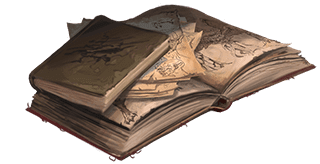
Artist: Suzanne Helmigh
Each monster hunter carries with them a grimoire of lore and research about the creatures they hunt.
Choose two types of monsters that you are specialized in hunting from the following list: aberrations, beasts, constructs, dragons, elementals, fey, fiends, giants, monstrosities, oozes, plants, undead, or humanoids (shape changers).
You add your proficiency bonus to any Intelligence and Wisdom checks you make that relate to the monsters in your grimoire. For example, an Intelligence (History) check to recall lore about a creature you’re investigating, or a Wisdom (Medicine) check to identify claw marks left on a corpse. If you are already proficient in a skill when asked to make an ability check relating to the monsters in your grimoire, you are treated as having expertise for the purposes of that ability check and double your proficiency bonus instead.
When you gain this feature, you also learn one language of your choice that is spoken by one of the monster types in your grimoire.
Other class features you gain also refer to the monsters in your grimoire.
A monster hunter’s grimoire is an object that is entirely unique to them. It may be a leather tome recovered from a dusty library with notes made in the margins, a frayed journal inherited from a previous hunter, or a precious stone with a communing spirit trapped within. If a monster hunter ever loses their grimoire, they have usually retained enough of the knowledge to not suffer any immediate disadvantages. However, they cannot further their research without one and therefore cannot take another monster hunter level at level up until a lost grimoire has been replaced. A grimoire can be recreated by spending 8 hours and 50 gp worth of materials such as pages, inks, or components to cast a ritual.
Hunter’s Instincts
At 2nd level, you gain the ability to analyze a creature and discern specific information about it. As a bonus action, choose one creature you can see within 60 feet of you, and make an Intelligence (Investigation) check where the DC equals 5 + the creature’s CR. The check is automatically successful against creatures with a CR less than 1. If you are successful, you learn one of the following pieces of information.
- The creature’s type.
- The creature’s armor class.
- Any damage resistances or immunities the creature has.
- Any damage vulnerabilities the creature has.
If you spend at least 1 minute observing or interacting with the target creature outside of combat, you can learn the first two pieces of information automatically, and the second two with a single Intelligence (Investigation) check of the same DC as described above.
If the creature is concealing any of these pieces of information with magic, such as an illusion, you do not learn that piece of information with a successful ability check but instead become aware that the information is being concealed.
Hunting Guild
At 3rd level, you choose a hunting guild that best reflects the techniques you employ in tracking and slaying monsters. Choose between the Carver Guild or the Trapper Guild, both detailed below. The guild you choose grants you features at 3rd level and again at 7th, 10th, 15th and 18th level.
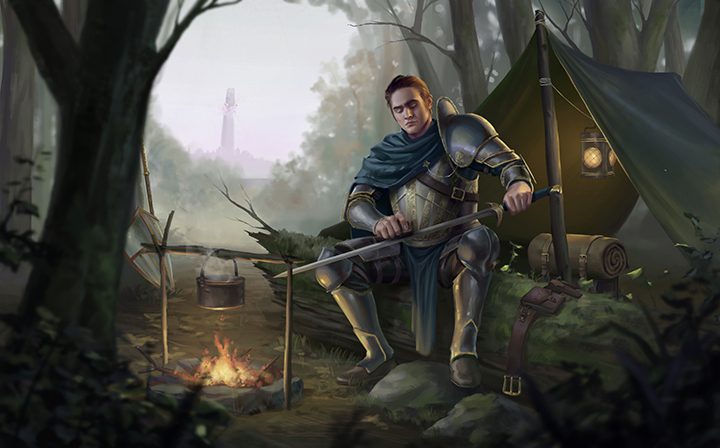
Artist: Elizabeth Peiró
Carver Guild
Since the beginning of time, monsters were fought by those who were brave enough to get close to danger and glare into its ferocious eyes. The folk that survived were those smart enough to arm themselves properly and know precisely where to strike for the quickest kill.
Carvers are the monster hunters that are typically called upon when immediate danger threatens a settlement and action is in short supply. Carvers stride unflinchingly toward death, armed with years of training and knowledge that is both researched and passed down from those before them.
Bonus Proficiency
When you choose this guild at 3rd level, you gain proficiency with heavy armor
Close Quarters
Starting at 3rd level, your resolve allows you to keep the pressure on your target while mitigating the risk to yourself. Whenever you hit a creature with a melee weapon attack you can mark them until the start of your next turn. While creatures that are marked are adjacent to you, they have disadvantage on attack rolls against you.
True Grit
Starting at 3rd level, you are immune to being frightened by creature types written about in your grimoire.

Artist: Elizabeth Peiró
Trapper Guild
Legends say that the founding members of the Trapper Guild were regular game hunters who had grown bored of the common elk and dreamed of taking down bigger game. Trappers take pride in their kills and the ingenuity exhibited when a trap works perfectly.
The legacy of the Trapper Guild is a consistent testament to the benefits of lying in wait. The element of surprise is paramount to the Trapper, whose kit can flourish before the hunter and monster even meet. Preparation is key, and the resourceful Trapper has devices to overcome even the strongest foes.
Bonus Proficiency
When you choose this guild at 3rd level, you gain proficiency in the Stealth skill.
Trapper’s Tools
Starting at 3rd level, you gain proficiency with Tinker’s tools and can use these to create gadgets and mechanisms that help you during the hunt. Whenever you finish a long rest, you can use your Tinker’s tools to craft two of the following trapper’s tools described below.
You can also spend 1 hour and 20 gold pieces worth of additional resources (such as equipment or monster salvage) to use your Tinker’s tools to craft a single trapper tool. The time spent must be uninterrupted and can be during a short rest.
Some trapper’s tools allow your target to make an ability check or saving throw to resist the tool’s effects. The saving throw DC is calculated as follows:
trapper’s tool Save DC = 8 + your proficiency bonus + your Intelligence Modifier
Elemental Ammo. The head of an arrow or bolt is tipped with poison, loaded with an acid vial, or dipped in flammable oil. You create a single piece of ammunition that can be fired from either a bow or crossbow as part of an attack action. If that piece of ammunition hits, it inflicts three times the weapon’s normal damage dice. The damage type can be either acid, fire, lightning, poison, or thunder, chosen when the ammunition is crafted.
A piece of elemental ammo breaks after use and cannot be recovered.
Push Plate. A chest guard, filled with compressed air or loaded with springs. It can be worn over clothing and armor and takes the same time to don and doff as light armor. If the wearer is hit by a melee attack, it can use its reaction to activate the push plate. If the wearer is larger than the creature who attacked it, the creature will be pushed back up to 20 feet. If the creature is the same size or larger than the wearer, the wearer will be pushed back up to 20 feet, instead.
The push plate is destroyed after a single use.
Scorpion Anchor. This weapon is intended to keep flying foes anchored to the ground or stop monsters from fleeing. The scorpion anchor can be fired from either a bow or crossbow as part of an attack action. A creature hit by the attack becomes grappled, ending the effect if it uses an action on its turn to succeed on a Dexterity (Acrobatics) or Strength (Athletics) check.
A scorpion anchor is destroyed after use and cannot be recovered.
Silver Bomb. Silver bombs are used when hunting creatures that are resilient to mortal weapons. As a bonus action on your turn, you can throw the silver bomb at a point that you can see within 60 feet, creating a 20-foot-radius sphere centred on that point. The sphere spreads around corners, and its area is lightly obscured. It lasts for 1 minute or until a wind of moderate or greater speed (at least 10 miles per hour) disperses it. While inside the sphere, any aberration, elemental, fey, fiend, humanoid, monstrosity or undead loses any resistances or immunities that it has to bludgeoning, piercing, and slashing damage.
A silver bomb is destroyed after a single use.
Terrain Cloak. A cloak composed of or disguised with local materials, allowing the wearer to conceal themselves within the environment. Terrain cloaks can be worn over light and medium armor and are donned and doffed with the speed of light armor.
The wearer of a terrain cloak is always lightly obscured. The wearer also receives advantage on stealth checks that rely on sight and can attempt to hide even if only lightly obscured by their terrain cloak.
Terrain cloaks tend not to last as the dust wears off and the dead branches break or whither. Terrain cloaks fall apart after 24 hours.
Weretrap. A strong staggering trap that is triggered when its fragile exterior is broken. You can use an action to set the trap on the ground in a space adjacent to you. Weretraps placed on the ground are invisible to other creatures unless they succeed a Wisdom (Perception) check. A creature that steps on the weretrap must succeed a Dexterity saving throw or take 3d10 bludgeoning damage and be knocked prone.

Artist: Suzanne Helmigh
The weretrap can also be used as a ranged weapon with the finesse and thrown property. It has a short range of 20 feet and a long range of 60 feet. On a successful hit, the weretrap deals 3d10 bludgeoning damage and the target is knocked prone.
The weretrap is destroyed after it is triggered or thrown, regardless of whether it was successful or not.
Predatory Awareness
Starting at 3rd level, you can’t be surprised by creature types written about in your grimoire while you are conscious.
Ability Score Improvement
When you reach 4th level, and again at 8th, 12th, 16th, and 19th level, you can increase one ability score of your choice by 2, or you can increase two ability scores of your choice by 1. As normal, you can’t increase an ability score above 20 using this feature.
Extra Attack
Beginning at 5th level, you can attack twice, instead of once, whenever you take the Attack action on your turn.
Grave Strike
When you reach 5th level, such is your learning in the weaknesses of monsters that you know patience and precision can often deal more damage than rapid strikes.
You can use an action on your turn to perform a grave strike, which is a single weapon attack. When doing so your Intelligence modifier is added to the attack roll and if the attack hits the weapon deals additional damage equal to 1d8 times your Intelligence modifier (minimum of 1d8).
A grave strike can also be performed as a reaction such as a readied action or an opportunity attack. You do not lose a use of this ability if the readied action is not performed.
You may use this ability a number of times equal to your Intelligence modifier (minimum of one) and regain all expended uses when you finish a short or long rest.
Grimoire Improvement
Once you reach 6th level, you have gathered enough information among the monsters you’ve slain to add another section to your Monster Grimoire.
You may select a new type of monster that you are specialized in hunting from the following list: aberrations, beasts, constructs, dragons, elementals, fey, fiends, giants, monstrosities, oozes, plants, undead, or humanoids (shape changers). You may not choose a monster type you have chosen before. All the benefits you gain from your monster grimoire now also apply to this new creature type.
Additionally, whenever you are making a weapon attack against a creature written about in your monster grimoire, you score a critical hit on a roll of 19 or 20.
Hunting Guild Improvement
Carver Guild: Improved Salvage
When you reach 7th level, you have learned every technique integral to efficiently carving the salvage from monster remains. You have advantage on ability checks made to harvest salvage, and whenever possible you collect twice as much.
Trapper Guild: Improved Crafting
When you reach 7th level, you better understand the nature of salvage gathered from monsters and how to craft those materials more efficiently. Whenever you want to craft an item from salvage, you may do so with half the amount of salvage necessary and in half the time. If it is not possible to craft the item with half the amount of salvage (such as creating a mace of disruption from the skull of a memori lich), you may half one other required cost instead.
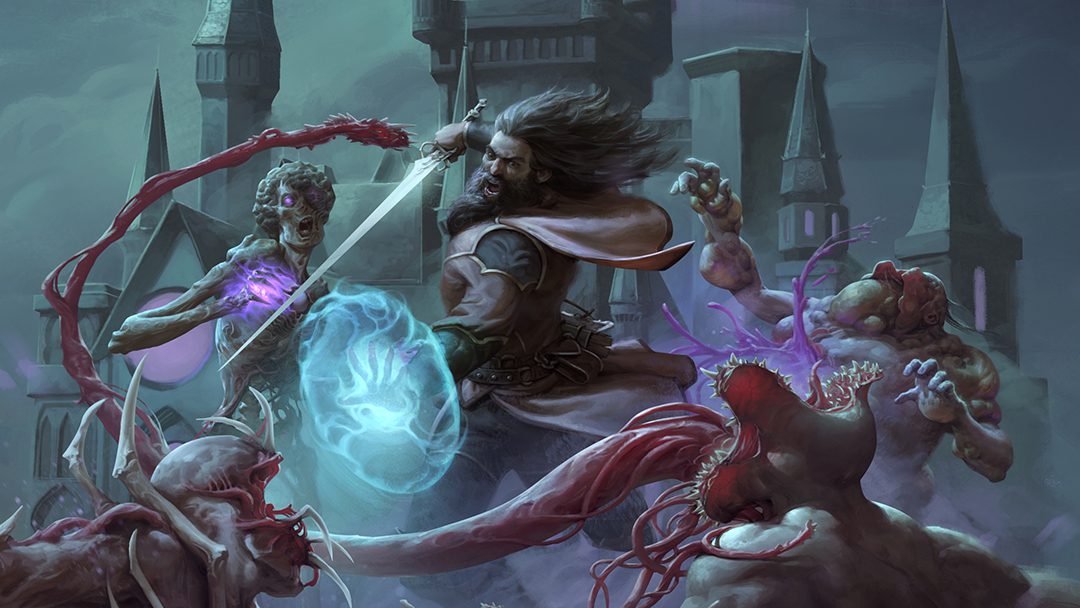
Artist: Toni Munteanu
“I didn’t know such things were possible before I met with Stelvi. Before we hunted alongside one another.
We were hired to kill a pack of beasts. They’d been mauling caravans and leaving the farmland empty. The lord who owned the land was concerned his stores would be empty if the crop couldn’t be harvested in time. The fool was more concerned about replenishing his tax reserves than preserving the lives of those he ruled. It meant he was willing to pay a high price to have the monsters slain – so much so he hired two of us rather than bothering to have us bid on the contract.
We found the monsters’ tracks amidst the aftermath of one of their ambushes. Their prints were unusual for a monstrosity. The scattered way they left the destroyed caravan suggested they weren’t particularly intelligent. But their prints were no griffins or basilisks that I recognized. It was Stelvi who pointed out they weren’t monstrosities at all. We were hunting a pack of fiends.
We rode the woodland paths three evenings before we were set upon by the creatures, ourselves. Six exploded from the underbrush as if birthed from the hells deep beneath the earth. They appeared as great lizards with dark, scaly spines.
We were far from where we’d set our own trap, but none save the largest among them were a match for the speed of our horses. Thankfully, for the monsters provided a fierce pursuit.
We lead them to the place where we wanted them. The weretraps I buried exploded and caught the largest by surprise. When I dismounted, I shot it with my crossbow and anchored it to the ground. Six seconds later the others were upon us.
I thought Stelvi was odd as soon as I met her. I remember her intense stare and amber eyes, yet the next day and since, they had been green. She maintained strange habits such as eating very little and never sharing a meal. She seemed concerningly under equipped for our profession, carrying naught but an unremarkable longsword and patchwork armor that fitted her poorly.
Despite this I chose to trust her. Worst case, she’d provide valuable seconds getting between me and a grasping claw.
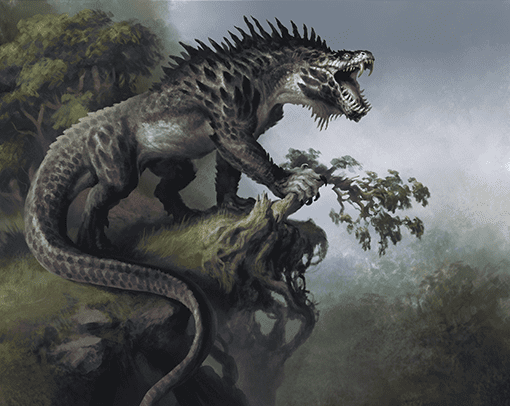
Artist: Brent Hollowell
As we rode in flight from the creatures, I watched her slather her mouth with a dark ooze that blistered her lips and blackened her teeth. While I restrained the largest monster, she spat on her sword and wiped the oily goo along the edge. When the first creature confronted her, she cut it open with an up-thrust and its insides sizzled and dissolved.
Two fell upon my horse and began to devour it. A third ran at me and I shot at its eye, but its jaws closed around my shoulder. I felt pain. Then I felt my body begin to lock up. A numbness spread from the wound. I’d have died in that moment save for the creature trying to pin me down beneath its claw. My push plate burst on my chest and forced me to stagger away.
As I caught my breath, the creature dashed towards me again. I breathed in. I waited. I saw the veins in its milky white eye. I fired my crossbow and, with a single bolt, the creature collapsed dead at my feet.
My horse was shrieking. When I looked back, the two creatures were gulping down chunks of stone. My steed had been transformed into a statue. I stretched my stiffened shoulder with concern.
Stelvi had killed a second of the monsters. She moved with a preternatural agility. Her eyes flashed amber once more, as if she had become possessed.
Together we slew the two that had eaten my horse. They had become slow from their meal. I was almost casual with my crossbow. Then I heard the ropes that had restrained the largest snap and we encircled it like two wolves around a bear.
The monster’s tail lashed out and Stelvi’s horse whinnied as it fell on its side. Its guts spilled onto the road.
Stelvi slashed at the monster’s face. I buried bolts in its hind. Then the creature turned in frustration and the dance reversed.
The wounds it was dealt by the other hunter hissed and burned. Black ooze dripped from her bottom lip. I could see her own injuries ooze black instead of red. And the realization sunk in. Stelvi was not entirely human herself.
When the final lupilisk was dead – their name learned from my hunting partner – Stelvi walked to her dying horse. She ended the animal’s misery with her sword. As I collected the scales and fangs from our prey, I watched her from the corner of my eye.
Stelvi knelt in the horse’s spilled offal. I thought she might be salvaging its heart or bones. Instead, she lifted its remains to her mouth devoured its innards. And as she did her wounds stopped bleeding and her bruises lost their dark color.
She caught me staring at her. I asked if she was human. She asked if she needed to be worried.
I was still holding my carving knife. She gripped the hilt of her sword.”
– From the grimoire of Jürgen of the Black Arrow
New Subclass: Devourer Guild

Artist: Suzanne Helmigh
Folk in Etharis do not always speak highly of monster hunters, and many consider them to be just as depraved and inhuman as the evils they are sent to vanquish. Many of the appalling tales told about monster hunters can be attributed to the Devourer Guild, accused of being monstrous cannibals themselves.
The truth is barely any better. Devourer’s have spent their days consuming the flesh and vitae of the monsters they have slain, and over time their metabolism has changed to tolerate this disgusting practice. Devourers adopt mutations shortly after consuming the substance their prey is made from.
Transmutating Metabolism
When you choose this guild at 3rd level, you gain the ability to consume portions from monster remains which cause your body to adopt powerful and frightening new mutations.
Salvaging Portions. A single portion can be salvaged from the physical remains of any creature. Unless it is consumed a portion lasts for 24 hours, before it either rots or its innate magic dissipates, and it no longer has any effect.
Consuming Portions. Whenever you spend a bonus action to consume a portion, you magically gain a benefit depending on the creature’s type. You can consume a number of portions up to 1 + your Constitution modifier (minimum of 1). Each portion you consume after that causes you to gain a level of exhaustion. When you finish a long rest, you regain the ability to safely consume portions. You can benefit from multiple portions at the same time but consuming more than one portion from the same monster type provides no additional effects.
If a portion effect enables you to cast a spell, Intelligence becomes your spellcasting ability.
Portion Effects
Aberrations. For the next hour you can speak telepathically to any creature you are aware of within 60 feet of you. Additionally, during that time you have resistance to psychic damage.
Beasts. You regain hit points equal to 2d8 + your monster hunter level.
Celestials. For the next hour you automatically know whenever you are being lied to. Additionally, once during that same period you can cast the branding smite spell innately.
Constructs. For the next ten minutes, you have resistance to bludgeoning, piercing, and slashing damage from non-magical attacks not made with adamantine weapons.
Dragons. For the next ten minutes, you grow leathery wings from your back which give you a flying speed of 50 feet.
Elementals. Choose one of the following damage types: acid, cold, fire, lightning, thunder. For the next minute whenever you take damage of that type, instead of losing hit points you instead gain hit points equal to the amount of damage that would be taken.
Fey. Once within the next ten minutes you can innately cast the invisibility spell requiring no material components.
Fiends. Once within the next ten minutes you can innately cast the charm person spell or the suggestion spell requiring no material components. This effect ends once you have cast either of these spells.
Giants. For the next minute you gain advantage on all Strength based ability checks and saving throws. You also add your Strength score to the damage twice for any Strength based weapon attacks you make.
Humanoids (Shape Changer). For the next hour you can magically polymorph your physical appearance. This functions similarly to the disguise self spell but with two key differences. Firstly, you cannot change the appearance of your clothing, weapons, or equipment. However, your disguise is physical in nature and stands up to physical inspection.
Monstrosities. For the next hour you gain natural weapons such as claws and fangs. Whenever you make an unarmed strike, you deal 1d6 slashing damage instead of the normal amount. You can also make an unarmed strike as a bonus action on each of your turns.
Oozes. For the next hour you can move through any space wide enough for a creature one size smaller than you without squeezing. Additionally, during that same period you can choose to deal acid damage with any weapon attack you make as your saliva and blood become corrosive to others.
Plants. For the next ten minutes you can innately cast the spike growth spell requiring no material components.
Undead. For the next minute whenever you inflict damage to a creature with a weapon attack, you gain temporary hit points equal to half the damage dealt.
Inherent Mutation
When you reach 7th level, your body begins to grow new permanent mutations because of your continued consumption of monsters. Choose two of the following mutations that become permanent for you.
Metabolized Constitution. You have advantage on saving throws against poison, and you have resistance against poison damage. If you already have or gain a similar ability due to another magic item, class, or racial trait (such as Dwarvern Resilience) you instead become immune to poison damage and immune to the poisoned condition.
Obsessive Consumption. You can now consume a number of portions up to 2 + your Constitution modifier (minimum of 2) before taking any levels of exhaustion.
Permanent Scales. When you are not wearing armor, your AC equals 13 + your Dexterity modifier.
Preternatural Reflexes. You can take the Dash or Disengage action as a bonus action on your turn.
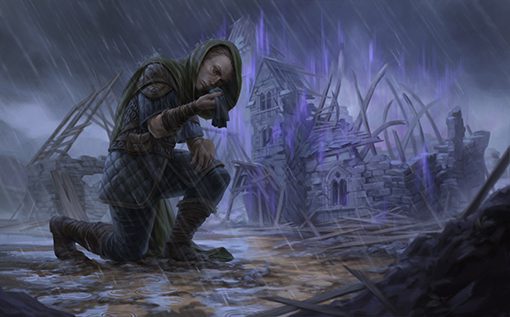
Artist: Marzena Nereida Piwowar
Rapid Recovery. You can use your action to spend a single Hit Dice, recovering hit points equal to the result + your Constitution modifier.
Terrifying Appearance. Your appearance becomes frightening to others to behold. You gain proficiency in the Intimidation skill. If you are already proficient in this skill you instead gain expertise, doubling your proficiency bonus whenever you make a Charisma (Intimidation) check.
Wall Crawler. You have a climbing speed equal to your movement speed, and can climb difficult surfaces, including upside down on ceilings, without needing to make an ability check.
Wolfen Senses. You have advantage on Intelligence (Investigation) checks and Wisdom (Perception) checks that rely on hearing or smell.
Recognized Professional
By 9th level, stories of your expertise in hunting monsters have spread and you have become a recognized professional in your field. You have advantage on Charisma checks against non-hostile creatures when plying your trade, such as when negotiating payment for a quest, asking for information about a monster, or selling monster salvage.
Hunting Guild Feature
Carver Guild – Grave Riposte
By 10th level you have learned to strike back and your foes who provide you an opening. If a creature you have marked within melee range misses you with an attack or attacks a creature other than you, you may use your reaction to immediately make a melee weapon attack or Grave Strike against them.
Trapper Guild – Ambushers Advantage
Starting at 10th level you have become a ferocious ambusher. You have a bonus to your initiative rolls equal to your Intelligence modifier. If you use Grave Strike against a creature that has not acted in combat yet, you can use your bonus action to make a single weapon attack as well.
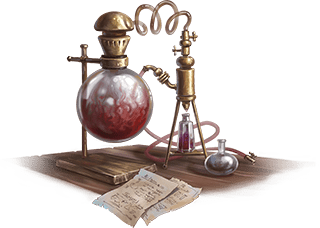
Artist: Ona Kristensen
Devourer Guild – Alchemical Decoctions
At 10th level, you gain proficiency with Alchemist’s supplies.
You can spend 1 hour and 20 gold pieces worth of alchemical ingredients (such as special herbs or monster salvage) to use your Alchemist’s supplies to convert a single portion into a decoction.
A decoction is a magic potion that functions exactly like a portion but has no limit on how long it lasts.
Creatures other than you can consume 1 decoction, gaining a level of exhaustion for each additional decoction they consume after that. After finishing a long rest, a creature regains the ability to safely consume a single decoction.
If a decoction enables a creature other than you to cast a spell, they may use their own spellcasting ability or use Constitution if they do not already have the ability to cast a spell.
Rapid Grave Strike
Once you reach 11th level, you are an expert at striking at the weaknesses of your prey. All your weapon attacks now deal an extra 1d8 of damage. You may also now choose to use Grave Strike as part of any Attack action instead of taking an entire action on its own.
Ability Score Improvement
When you reach 4th level, and again at 8th, 12th, 16th, and 19th level, you can increase one ability score of your choice by 2, or you can increase two ability scores of your choice by 1. As normal, you can’t increase an ability score above 20 using this feature.
Grimoire Improvement
By reaching 13th level, you have gathered enough information among the monsters you’ve slain to add another section to your Monster Grimoire.
You may select a new type of monster that you are specialized in hunting from the following list: aberrations, beasts, constructs, dragons, elementals, fey, fiends, giants, monstrosities, oozes, plants, undead, or humanoids (shape changers). You may not choose a monster type you have chosen before. All the benefits you gain from your monster grimoire now also apply to this new creature type.
Knowledgeable Defence
By 13th level, you have studied the ways in which your foes attack and trained your body and mind to resist them. You are considered proficient with any saving throw made against a creature written about in your Monster Grimoire. If you are already proficient when asked to make the saving throw, you may add your proficiency bonus a second time.
Hunter’s Instincts Improvement
Beginning at 14th level, you have honed your hunter’s instincts to the point of only needing clues a creature has left behind to learn information about them. These clues could include tracks or claw marks, standing inside the monster’s lair, the remains of one of their victims, or even an accurate description given by a witness.
As an action you can make an Intelligence (Investigation) check while considering one of these clues. The DC equals 10 + the CR of the creature who left the clue, the check automatically successful against creatures with a CR less than 1. If you are successful, you learn one of the following pieces of information.
- The creature’s type.
- The creature’s armor class.
- Any damage resistances or immunities the creature has.
- Any damage vulnerabilities the creature has.
If the clue is misleading in any way, such as being an illusion or an inaccurate witness account, you do not learn any information with a successful ability check but instead become aware that the clue is misleading.
Hunting Guild Feature
Carver: Terror of Terrors
By 15th level your reputation has become such that monsters who prey on the fearful have come to fear you. When you mark a creature using a Grave Strike attack, you can force the target to succeed on a Wisdom saving throw or become frightened of you until the end of your next turn.
The saving throw DC is calculated as follows:
DC = 8 + your proficiency bonus + Strength or Dexterity modifier (your choice)
Trapper – Monster Hide Armor
At 15th level you have learned to modify a set of light or medium armor by crafting dragon scales, werewolf hide, troll leather, or similar monster salvage onto the armor. The armor takes on the appearance of your choice, reflecting the salvage it is made from. It is assumed you have been working on this armor during your down time, however a final 4 hours of uninterrupted work with your Tinker’s tools and a suit of light or medium armor is required to complete it.
Your Monster Hide Armor has the same properties as the light or medium armor it is made from plus two additional features you choose from the following list.
Damage Resistance. The monster hide used to craft your armor transfers its resistances. Choose 3 damage types when you craft the armor. You have resistance to these damage types while wearing your armor.
Elemental Charge. Your armor may be embedded with a construct’s gemstone or infused with the power of an elemental. When you craft your armor, you imbue it with one of the following damage types: acid, cold, fire, lightning, poison, or thunder. Whenever you make a weapon attack, you may choose for the damage to be the weapon’s normal damage type or your armor’s imbued damage type.
Hardened Defense. Hardened scales or magical pelt make your armor difficult to pierce. You have a +2 bonus to AC while wearing this armor.
Regeneration. Possibly made from troll hide or infused with vampire blood, while wearing your armor you can use a bonus action to regain hit points equal to 1 hit dice plus your Constitution modifier. You may do this 6 times, regaining the ability to do so after completing a short or long rest. Using this ability does not spend a hit dice.
Stealthy. Your armor is draped with a shadowy cloak or made from hide as light as a feather. Your armor does not impose disadvantage on Dexterity (Stealth) checks even if it would normally. While wearing your armor you have advantage on Dexterity (Stealth) checks made to hide, and Wisdom (Perception) checks made to perceive you have disadvantage.
Phase Leap. You may have powdered your armor with fey dust or sewn it with the pelt of a phase shifting monstrosity. You can use a bonus action on your turn to teleport up to 60 feet to an unoccupied space you can see. You may do this up to 3 times, regaining the ability to do so after a short or long rest.
You can only have a single monster hide armor constructed at a time. You can change the features of your current armor with 4 hours of uninterrupted work using your Tinker’s tools. If you craft a new suit using 8 hours of uninterrupted work with your Tinker’s tools and a suit of light or medium armor, it is assumed the old armor has become too damaged to function or you have salvaged parts from it to craft the new one.
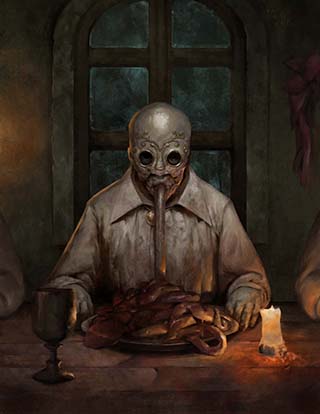
Artist: Stanislav Dikolenko
Devourer – Monstrous Gluttony
When you reach 15th level you have become so ravenous for the power monsters give you that you are willing to feast on their still living flesh. You may spend one use of Grave Strike to instead make a special melee weapon attack using either Strength or Dexterity. The attack deals 1d6 piercing damage plus 1d8 force damage times your Intelligence modifier (minimum 1d8).
If this attack is successful, after dealing damage you instantly count as having consumed a portion of the same creature type as the target of the attack.
Ability Score Improvement
When you reach 4th level, and again at 8th, 12th, 16th, and 19th level, you can increase one ability score of your choice by 2, or you can increase two ability scores of your choice by 1. As normal, you can’t increase an ability score above 20 using this feature.
Monster Grimoire Improvement
At 17th level you have gathered enough information among the monsters you’ve slain to add a final section to your Monster Grimoire.
You may select a new type of monster that you are specialized in hunting from the following list: aberrations, beasts, constructs, dragons, elementals, fey, fiends, giants, monstrosities, oozes, plants, undead, or humanoids (shape changers). You may not choose a monster type you have chosen before. All the benefits you gain from your monster grimoire now also apply to this new creature type.
Hunting Guild Feature
Carver – Tireless Hunter
By 18th level, if you have no uses of Grave Strike remaining when you roll initiative, you gain one use of Grave Strike.
Trapper – Rapid Tinkerer
When you reach 18th level you have become capable of crafting trapper tools at a much faster rate. When you finish a long rest, you can now craft three trapper’s tools instead of two.
Devourer – Acquired Taste
At 18th level your hunger for monster portions has increased as has your capacity to safely devour them. You can now consume 1 additional portion or decoction before gaining a level of exhaustion between long rests.
Grave Execution
At 20th level if a creature from a type written about in your Monster Grimoire has 50 hit points or less remaining when you hit it with a Grave Strike, you can force the target to make a Constitution saving throw. On a failure the creature is immediately reduced to 0 hit points, while on a success the Grave Strike deals its damage as normal.
Calculate the save DC as follows:
DC = 8 + Proficiency Bonus + your Strength or Dexterity modifier (your choice)
Counter CharmStarting at 3rd level, you have advantage on saving throws against spells cast by creatures from a monster type contained in your monster grimoire.Additionally, when a creature you can see within 60 feet of you casts a spell or makes a spell attack; you can use Studied Response before the spell is cast or the attack roll is made.Mage HunterStarting at 7th level, you consider any humanoid that can cast at least 1 spell as being from a monster type written about in your monster grimoire.Additionally, when you damage a creature from a monster type listed in your monster grimoire, that creature has disadvantage on the saving throw it makes to maintain its concentration if it is concentrating on a spell.Occult KnowledgeBy 10th level, your knowledge of magic has increased so that you learn to cast rituals. You can cast a spell as a ritual if that spell has the ritual tag and it’s a spell you know.In addition to the spell you learn at 10th level, you also learn two more spells from any spell list. These two spells must be of a level for which you have spell slots and must have the ritual tag. When you reach 14th level in this class, you can replace one of the spells you know from this feature with another spell of your choice from any spell list. The new spell must be of a level for which you have spell slots and must have the ritual tag.Magical AegisAt 15th level, you gain the ability to extend your protective charm to your allies. You and friendly creatures within 20 feet of you have advantage on saving throws against spells cast by creatures from a monster type written about in your monster grimoire.Additionally, you learn counterspell if it is not a spell you already know. You can cast counterspell once without expending a spell slot. You must finish a long rest before you can do so again.Arcane Response At 18th level, you have learned to anticipate your enemies well enough to rapidly cast spells in response to their attacks. When you use Studied Response, instead of making an attack you can cast a cantrip or spell with a casting time no greater than 1 action.


No Comments